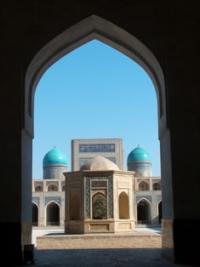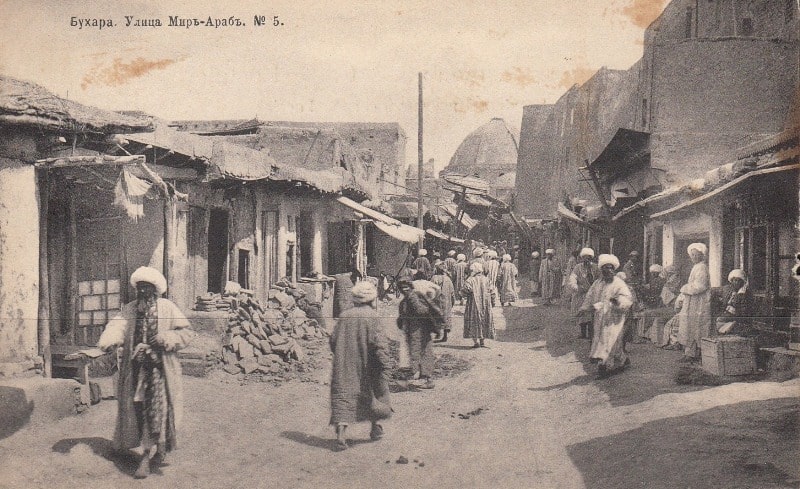You are here
Miri Arab Madrasah.

Individual tour to Bukhara.
"When they came in from daylight here... it seemed that the ghosts scattered and stopped in the corners. There were no windows, only the alabaster pandjara went inside the huge dome over the Miri-Arab mosque, and if you look there, the fear increased, as if looking into the otherworldly sphere the universe "
Sadriddin Ayni.
Vacation package in Bukhara.
Miri Arab Madrasah is situated opposite to the Kalon Mosque. This is one of the most esteemed spiritual Islamic universities all over the world. Madrasah was built at the Sheybanids’s governing in the XVI century in account of trophies of the nephew of Sheybanikhan - Ubaydallahkhan.
Khan gave them to his teacher - the head of Bukhara Muslims Miri. The Miri Arab madrasa (1535) across the plaza forms, with the mosque, Bukhara's pain kosh ensemble. One of only two working madrasahs allowed in the Soviet Union (the other was in Tashkent), it has never closed to students and never opened to tourists who can glimpse from outside the calligraphy and mosaic round the drums supporting its two blue domes, but still miss out on some of the finest ceramic decoration in Bukhara.
Madrasah was built at the Sheybanids’s governing in the XVI century in account of trophies of the nephew of Sheybanikhan - Ubaydallahkhan. Khan gave them to his teacher - the head of Bukhara Muslims Miri.
The last came from Yemen and was a pupil of Khodja Akhrar. Madrasah has traditional layout. There are two floors of hudjras surrounding four-ayvaned courtyard. Its 120 - 130 students study Islamic law and literature and Arabic for five to seven years, and live in two storeys of cells with balconies round the central courtyard.
Their main assembly hall is under the dome to the right of the pishtak. The main facade in the center has a portal with two-storied loggias. Facade is flanked with small towers - guldasta from both sides.
In the center of gurkhana (burial vault) there is a wooden gravestone of Ubaydallahkhan. Sheikh Miri Arab's tomb is situated at the head. We can see carved mosaic in the decoration of the mosque.
This construction is included into the ensemble of the minaret and the mosque of Kalon. Nowadays, there is an acting spiritual school on the territory of this madrasah. Under the left dome are buried Ubaydullah Khan (one of the first Bukharan royals not to have his own mausoleum) and Sheikh Miri Arab after whom the madrasa is named.
He is variously described as an architect, a Yemeni merchant, and 'spiritual mentor of the early Sheibanids'. He may have been all three. He certainly seems to have been foreign, to have founded the madrasa and to have paid for it with money made by Ubaydullah from the sale of 3000 Persian slaves, or Shiites branded slaves for belonging to the wrong Muslim sect in a Sunni city.
Next to and south of the madrasa, the Amir Alim Khan madrasa was built near the start of the 19th century. With separate courtyards for living and working it breaks all the architectural rules for madrasas and was always more important as a library, which it still is, though now for children.

Authority:
V.G Saakov «History of Bukhara». Publishing house "Shark", 1996. «Bukhara. Masterpieces of the Central Asia». The historical guidebook across Bukhara. 2012. "Bukhoro. Bukhara" In the Uzbek, English and Russian languages. Publishing house "Uzbekistan", Tashkent 2000. Mukhammad Narkshakhi. History of Bukhara. Tashkent. 1897 (translator N.Lykoshina). V.G.Saakov "Architectural masterpieces of Bukhara. A Bukhara regional society "Kitabhon" Uzbek SSR, Exactly 1991 Robert Almeev. "History of ancient Bukhara". (Under edition of the Academician of the Academy of sciences of Republic Uzbekistan of Rtveladze E.V.)
Photos
Alexander Petrov.







